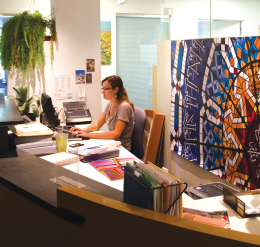
MICHELLE XU FOR THE HOYA
The Arabic and Islamic studies department is experiencing growing pains.
To accommodate a spike in student interest, the Arabic and Islamic studies department has undergone recent expansions — but not without some growing pains.
This fall, the department has increased its presence on campus, in part by organizing two lecture series for the year, but it has also struggled to keep up with demand for enrollment.
It took two weeks for Matt Lightfoot (SFS ’14), who waswaitlisted alongside about 20 other students, to get into a second-year Arabic course.
“It was a huge pain,” he said. “It was not fun … not knowing every day whether I’d even be able to take Arabic.”
When he worked with the department to find a spot in a course, Lightfoot was told that there were not enough professors to meet the demand for classes. Eventually, he was allowed to join a class that had already reached its capacity of 16 students.
“They pretty much caved and … gave the professors authorization to sign add/drop forms and increase class size,” Lightfoot said. “It’s working out so far, but it’s not ideal.”
The rapid upswing in student interest — a Modern Language Association study found that the national number of university students enrolled in Arabic language classes increased by 46.3 percent between 2004 and 2009 — coupled with internal changes — has forced the department to innovate.
“In the past few years, our program has moved to include more content-based courses, such as those on Islamic civilization and culture. Here, students write and communicate in Arabic, and we offer content courses in both Arabic and English,” Director of Undergraduate Studies Reem Bassiouneysaid.
These shifts have come with some challenges. Nick Childress (COL ’14), a student in advanced intensive level I, spent an uncomfortably long time on the waitlist at the beginning of the semester expressed annoyance with the department’s apparent lack of a unified teaching method.
“Some people use the book; some just ignore it. Others just won’t teach certain parts of Arabic,” Childress said. “They’re just all over the place.”
At the same time, he lauded individual professors within the department.
“I mean, they wrote the book,” Childress said, referring to the fact that the textbooks used in most Arabic classes across the country were published by Georgetown University Press. “I definitely get the impression that [Georgetown professors] are better than any other professors out there.”
Many professors in the department are well regarded in their field, including professor John Esposito, director of the Prince Alwaleed Bin Talal Center for Muslim-Christian Understanding and an authority on the Islamic world, and Bassiouney, who is a prize-winning Arabic fiction author.
While some students chose Georgetown’s program based on its reputation, others simply stumbled upon it.
“My freshman year, it was the popular thing to do,” Charlie Caris (COL ’13) said. “So I signed up for a class and ended up loving the professor.”
Alli Heymann (SFS ’16), who is taking her first Arabic course this semester, expressed similar enthusiasm for the program.
“It’s intensive, but I like the repetition and being constantly immersed,” she said.
While the department still has issues to address caused by the jump in its popularity, Caris was optimistic about Arabic at Georgetown.
“On the most important issues, they’ve done a fantastic job,” he said.














